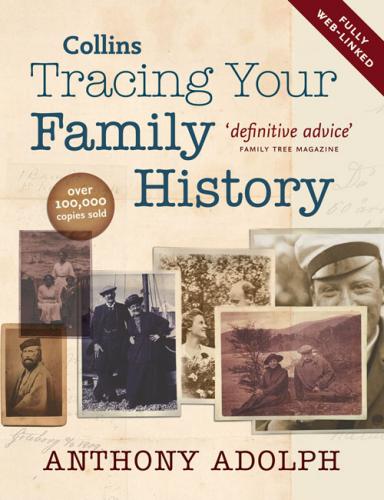AND, IF ALL GOES EXCEPTIONALLY WELL …
CHAPTER TWO WRITING IT ALL DOWN
The rest of this book is about how to trace your ancestry, but this chapter focuses on how to record your findings, from getting all your notes written down on computer or paper and moving onto understanding the family tree conventions.
Your Family Tree and Family History Monthly genealogical magazines.
Some people can get bogged down in choosing computer packages, filing systems and so on. Frankly, if you enjoy computer programs, then you’ll love family history, as there is a vast array to chose from, reviewed and advertised in the genealogical magazines like Your Family Tree and Family History Monthly, with an excellent comparative chart at www.Myhistory.co.uk. Everyone has a preference. Personally, I don’t rate very highly the packages that invite you to fill in forms about all your ancestors. I feel it de-humanises them and encourages some people to become obsessed simply with the act of form filling with completing forms that can’t be. Me? I keep a cardboard file for each family I am tracing, containing photographs, documents, notes and so on, and a rough family tree on paper, and then maintain a narrative pedigree on my word processor. Once I feel satisfied with what I have done, I may also write up a summarised version of the family story, including the best pictures and documents, either to circulate among the family or to submit to a relevant family history journal (see here).
GETTING IT ON PAPER
The main point at this stage is to write everything down. Be they oral or written, quote your sources precisly. Later, you can interpret the sources, but if you do this initially and discard the original information, and then find that your interpretation of the sources had been wrong, you (or someone else trying to help you – and, believe me, I’ve been there!) may have a terrible time disentangling what is correct from what is not. This applies just as much to interviewing people as to record-based research. In addition, always write down exactly what records you were searching, for what periods and for what you searched. If you do, and later you find that you are stuck, you may rely on your notes to tell you, say, that you looked under Thompson and also Thomson, thus potentially saving yourself a repeat journey to a record office to perform a search you had, in fact, already carried out but forgotten about.
THE BASIC FAMILY TREE
CRANE PRINTS
OLD FAMILY TREES were drawn with the names of parents in circles and their children radiating out below them. This arrangement was thought to resemble the footprints of Cranes in the soft mud of river banks, hence their name ‘Crane’s foot’ – ‘pied de Cru’ – pedigree!
There are several different types of family tree. These are:
‘Family trees’ and ‘pedigrees’, sometimes prefixed with the term ‘dropline’ (a chart with the earliest ancestor at the top and each subsequent generation connected by dropping lines), are one and the same – charts depicting a line or lines of ancestry.
‘Narrative pedigrees’, which are family trees written down in paragraphs, a style that is used by Burke’s Peerage and which is a highly effective way of recording a lot of information in a small space, but which isn’t so good for easily seeing who’s related to who. It is not much use for conducting original research, when only a family tree will make everything clear.
Seize quartiers, which spread out either like trees or in concentric circles, to show both parents, all four grandparents, the eight great-grandparents and – if you can manage it – all 16 great-greats. The original purpose of seize quartiers was snobbish, as you had to prove that all 16 were noble if you wanted to join foreign orders of knighthood like the Golden Fleece. Now, however, they are a good way of showing you have traced your family exhaustively. But don’t feel obliged and become exhausted, this is supposed to be fun and you can aim to trace as much or as little as you want.
Part of my mother’s family tree, showing how Germans Printed pedigrees in the 1930s.
CHARTING CONVENTIONS
= Indicates a marriage, accompanied by ‘m.’ and the date and place
— Solid lines indicate definite connections
… Dotted lines indicate probable but unproven ones
– – Loops are used if two unconnected lines need to cross over
Equally, there are no rules about what you can or can’t include on a family tree. Put in as much or as little as you want and include as many families as you want, though beware of cluttering. I would recommend a minimum of full names, dates of birth or baptism, marriage and death or burial, where those events took place, and occupations. If your chart lacks any of these, it will be of little use to other researchers and, more importantly, it will be boring. If you know someone was crushed to death by a bear or invented the casserole dish, for goodness sake put it on the chart!
There are some sensible conventions and abbreviations, which you’ll need to know both for compiling your own charts and understanding other peoples’. These have been outlined above.
Marriage bond for John Nursey, surgeon of Coddenham, Suffolk.
EXPANDING ON THE BASICS
When it comes to
